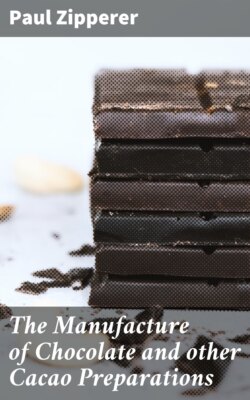Читать книгу The Manufacture of Chocolate and other Cacao Preparations - Paul Zipperer - Страница 7
На сайте Литреса книга снята с продажи.
c) Cultivation of the Cacao Tree; Diseases and Parasites.
ОглавлениеThe first information regarding the cultivation of the cacao tree in Mexico is that obtained on the invasion of the country by the Spaniards. Prior to that time there is a total absence of anything definite. The tree flourishes best in situations where the mean temperature is between 24° and 28° C. The farther the place of cultivation from the equator the poorer is the product. The other most essential conditions are long continued moisture of the soil and a soft, loose texture with abundance of humus, and above all, shelter from the direct rays of the sun. For these reasons, planters select for their cacao areas ground the virgin soil of which has not been exhausted by the cultivation of other plants. The plants are either raised in a nursery until they reach the most suitable age for transplanting, or the seeds are sown on the ground selected for the plantation. The transport of live seed for new plantations is attended with some difficulty, since the seeds very quickly lose their vitality. C. Chalot4 recommends that this vitality be preserved by gathering the fruit before it is perfectly ripe, immersing it in melted paraffin oil, and then wrapping it in paper; on which the fruit may be transported without losing any of its nutritive qualities.
In the sheltered valleys of tropical countries, where the soft soil, rich in humus, is kept constantly moist by large rivers, the cacao tree blossoms throughout the whole year. When growing wild it is generally isolated under the shadow of larger trees; when cultivated, the young plant is placed under the shelter of banana trees, and at a later period of its growth shelter is provided by the coral (called Erythrina corallodendron or Erythrina indica), further known as “Coffie-mama” among the Surinam Dutch and madre del cacao among the Spaniards. Yet this tree, like the Maniok, is said not to enjoy so long a life as the cacao plant, which sometimes reaches an age of forty years. On this account the Castilloa or also Caesalpina dashyracis have recently been recommended as a more lasting protection. The fact that it does not lose its leaves during the dry season (e.g. on Java, during the East Monsoon) is an additional advantage.
A cacao plantation requires a considerable area, in the proportion of 50 hectares for 20,000 trees. The quantity of fruit to be obtained from that number of trees, as an annual crop, would be worth from £ 1,200–1,300. In planting the seeds, they are set in rows that are from 8 to 10 m. apart, four or five seeds being planted within from 1 to 2 m, the shading trees being planted between the rows. Of each five seeds planted the greater number often fail to germinate, either in consequence of unfavourable weather or as the result of attacks by insects etc.; but if more than one plant grows, the weaker ones are pulled up. Until the plants are two or three years old, they are protected by a shed open at one side, and they are transplanted after they have attained a height of 3 ft. The chief enemies of tropical cultivation—weeds, aerial roots, insects, bacterial infection—have to be provided against continually, so as to prevent damage; accordingly if the ground be not moist enough, it should be systematically watered, and so drained if marshy, for the tree requires most careful nursing if it is to develop into a prolific fruit-bearing specimen. The seed germinates about fourteen days after being planted; but flowers are not produced till after 3 or 5 years. After the tree has once born fruit, which may occur at the end of the fourth year it often continues to do so for fifty years. The tree is most prolific when from twelve to thirty years old.
As in the case of all cultivated plants and domestic animals, the existence of which does not depend on the principal of natural selection, and among which life is not a continuous development of endurance in the face of adverse elements, the cacao tree has its peculiar diseases. Indeed, it would seem as though it were beset by all vermin extant. The reader may obtain some idea of the extent of the damage done to cacao plantations by such noxious agents, if he turns up the clear and exhaustive account published by the Imperial Biological Institute for Agriculture and Forestry (Germany).5 Unfortunately we have not space here to mention more than a few of the most frequently occurring and important diseases, such as the GUM DISEASE, which is especially destructive, gum formations in the wood tissue and bark of the tree eventually killing it. Next to be dreaded are the various fungus growths, cancers and cancer-like incrustations (“Krulloten”) and broom formations. It often happens that specii of beetle attack the tree, causing decay and rot to set in; such e.g. are the wood-borer, bark bug, and woodbeetle. Other parasites, again, do not destroy the whole tree, but are equally detrimental, as they also preclude all prospects of a harvest. Fruit rot and its like, fruit cancer, and cacao moths, are notorious in this connection. There are also several larger creatures which betray a preference for the nutritious fruit of the cacao tree, various species of rat, and the squirrel, which unite to make the planter’s life a burden.
